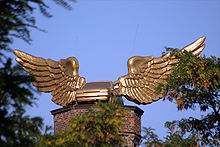HA Schult
From 1967 to 1978 he lived as an artist in Munich and has also performed a range of diversified jobs over time, including a spell as a taxi driver.
[19] Schult works in the tradition of Pop Art, being influenced by commercial advertising and a critical view of consumerism,[20] but also creates happenings.
[29] Schult describes himself as an ardent proponent of the "new ecological consciousness" and was referred to as an "eco-art pioneer" by Washington Post writer Rachel Beckman.
[3] Art historian Jens Christian Jensen wrote about Schult: "I do not know another German artist who grasps his tasks so comprehensively, no one who has such a sense of feeling for that what matters in our times.
"[22][32][33] According to art historian Gail Levin (Rutgers University), Schult "has made a biting commentary on the indulgent aspects of western society.
"[34] In 1969, Schult and two of his fellow artists, Ulrich Herzog and Günter Sarrée, were arrested for covering a street in Munich with trash and paper; they referred to the event as a "happening" and dubbed it "Situation Schackstrasse".
[37][39][40] Many of these "situations" shown in over-dimensional glass show cabinets are miniature landscapes consisting of trash, small children's playthings and bacteria, thereby promoting the archeology of an anticipated future.
For instance, in an obvious allusion to Neuschwanstein Castle, Schult created Schloss Neu-Wahnstein (1983-1987, Museum Ludwig, Cologne), "built on traditional assembly techniques of Dadaism.
[37][46][47] Venezia vive: In 1976, the artist filled St. Mark's Square in Venice with old newspapers in an overnight action that surprised the Venetian people and authorities.
Citing the protection of historic monuments, Franz-Josef Antwerpes, the former District President of Cologne, demanded the removal of the car but the competent ministry decided that the artwork could stay in place “temporarily”.
Schult's installation inspired Chinese artist He Chengyao's first piece of performance art titled Opening the Great Wall.
[27][60][61] Friedensspeicher: In 1998, he created the Peace Storage Building in the harbour of Osnabrück made of thousands of corrugated boxes carrying the inscription "piece" in different languages.
[69] Save the Beach: In 2010, Schult created a hotel made of garbage in order to raise awareness of the amount of waste being washed up on European shores.
[22][75] In 2015, Schult started his Action Blue world tour with a hybrid electric car from Paris to Beijing, which critically reflects the natural resources air and water on earth.
[76][77][78] This journey, including stops at various art and cultural institutions, took him from Paris via Luxembourg, Trier, Karlsruhe, Cologne, Düsseldorf, Melsungen, Berlin, Warsaw, Vilnius, Riga, Tallinn, Saint Petersburg, Moscow, Nizhny Novgorod, Kazan, Chaykovsky, Ufa, Chelyabinsk, Petropavl, Astana, Karaganda, Balkhash City, Balkhash Lake, Almaty, Dunhuang, Yueya Quan, through the Gobi desert and Yinchuan, Yan'An, Xi'an, Taiyuan, Shijiazhuang to Beijing.
[81] In an interview in Frankfurter Allgemeine Zeitung on the occasion of the artist's 70th birthday, Philip Krohn noted that art critics have described Schult's work as overly commercial and shallow, and said that he has had no new ideas in a long time.





